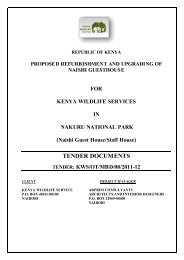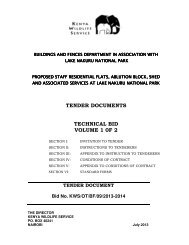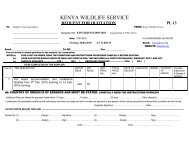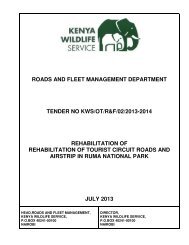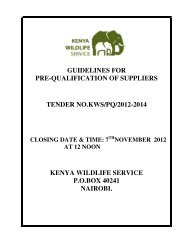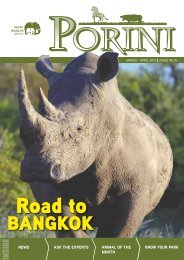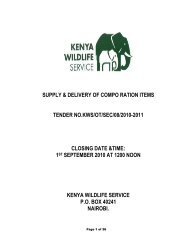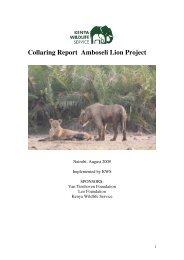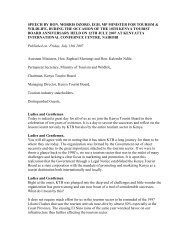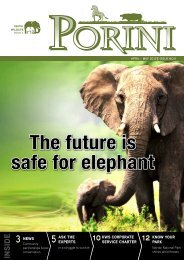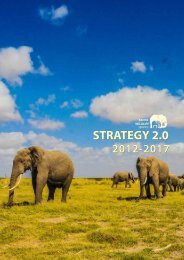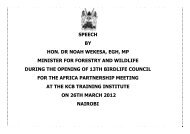Conservation and Management Strategy for the Elephant in Kenya
Conservation and Management Strategy for the Elephant in Kenya
Conservation and Management Strategy for the Elephant in Kenya
You also want an ePaper? Increase the reach of your titles
YUMPU automatically turns print PDFs into web optimized ePapers that Google loves.
CONSERVATION AND MANAGEMENT STRATEGY FOR THE ELEPHANT IN KENYA 23<br />
Generation of revenue by l<strong>and</strong>owners through community-based natural resource management (CBNRM) <strong>and</strong><br />
elephant-friendly l<strong>and</strong> use <strong>in</strong>itiatives is seen as more susta<strong>in</strong>able <strong>and</strong> directly empower<strong>in</strong>g, allow<strong>in</strong>g <strong>in</strong>dividuals<br />
<strong>and</strong> groups to control <strong>the</strong>ir level of responsibility, <strong>in</strong>vestment <strong>and</strong> return. Non-consumptive, essentially<br />
ecotourism-related, activities are <strong>the</strong> only <strong>in</strong>itiatives possible under <strong>the</strong> current policy. Sources of <strong>in</strong>come could<br />
<strong>in</strong>clude employment by lodges, partnerships between commercial operators <strong>and</strong> l<strong>and</strong>owners (leases, employment,<br />
jo<strong>in</strong>t ventures), community-operated conservancies or camps <strong>and</strong> cultural tourism. Tourism operations must<br />
con<strong>for</strong>m to zon<strong>in</strong>g <strong>and</strong> plann<strong>in</strong>g <strong>and</strong> not damage <strong>the</strong> resource or relations with local l<strong>and</strong>owners. O<strong>the</strong>r sources of<br />
support <strong>in</strong>clude NGOs, which offer <strong>the</strong> possibility of tra<strong>in</strong><strong>in</strong>g, employment <strong>and</strong> <strong>the</strong> ability to leverage fund<strong>in</strong>g <strong>and</strong><br />
<strong>in</strong>novative revenue sources such as trust funds with <strong>in</strong>ternational <strong>and</strong> local donors, foundations <strong>and</strong> Payment <strong>for</strong><br />
Ecosystem Services (PES) schemes. Cross-sector <strong>and</strong> <strong>in</strong>-k<strong>in</strong>d benefits <strong>in</strong> <strong>the</strong> fields of education (schools, bursaries)<br />
<strong>and</strong> <strong>in</strong>frastructure (cl<strong>in</strong>ics, roads) l<strong>in</strong>ked to elephant conservation should also be supported.<br />
7. Roles / responsibilities of stakeholders<br />
KWS is recognised as hav<strong>in</strong>g <strong>the</strong> m<strong>and</strong>ate <strong>for</strong> elephant management, identify<strong>in</strong>g priorities <strong>in</strong> consultative processes<br />
<strong>and</strong> hav<strong>in</strong>g <strong>the</strong> responsibility to support stakeholders at all levels, empower<strong>in</strong>g l<strong>and</strong>owners <strong>and</strong> harmonis<strong>in</strong>g <strong>the</strong><br />
activities of o<strong>the</strong>r national <strong>and</strong> <strong>in</strong>ternational governmental agencies. People expect KWS to support community<br />
<strong>in</strong>itiatives, provide security from poachers <strong>and</strong> HEC <strong>and</strong> ma<strong>in</strong>ta<strong>in</strong> partnerships with CBOs <strong>and</strong> community wildlife<br />
associations, NGOs <strong>and</strong> o<strong>the</strong>r government departments. L<strong>and</strong>owners are seen to play a crucial role <strong>in</strong> ma<strong>in</strong>ta<strong>in</strong><strong>in</strong>g<br />
elephant habitat, <strong>and</strong> <strong>the</strong>re is strong need <strong>for</strong> <strong>the</strong>ir enhanced <strong>and</strong> well-def<strong>in</strong>ed decision-mak<strong>in</strong>g rights. At <strong>the</strong> same<br />
time, l<strong>and</strong>owners also have responsibilities <strong>for</strong> conservation of elephant populations <strong>and</strong> habitats <strong>and</strong> cooperation<br />
with KWS. O<strong>the</strong>r government departments should harmonise with KWS, recognis<strong>in</strong>g conservation as a legitimate<br />
l<strong>and</strong> use <strong>and</strong> ‘ma<strong>in</strong>stream’ conservation <strong>in</strong> <strong>the</strong>ir operations, <strong>in</strong>clud<strong>in</strong>g conservation education <strong>in</strong> school curricula.<br />
NGOs <strong>and</strong> private sector should assist with fund-rais<strong>in</strong>g, tra<strong>in</strong><strong>in</strong>g <strong>and</strong> <strong>the</strong> promotion of open, honest dialogue,<br />
l<strong>in</strong>k<strong>in</strong>g national <strong>and</strong> <strong>in</strong>ternational conservation best practice with community development.<br />
8. International issues<br />
There are three key trans-frontier populations along <strong>the</strong> border with Tanzania, with small populations adjacent to<br />
Ug<strong>and</strong>a <strong>in</strong> <strong>the</strong> west, <strong>and</strong> Ethiopia <strong>and</strong> particularly Somalia <strong>in</strong> <strong>the</strong> north. There should be regular consultation on <strong>the</strong><br />
prospects <strong>for</strong> harmonisation of management strategies between <strong>Kenya</strong> <strong>and</strong> its neighbours, with <strong>the</strong> possibility of<br />
an East African regional elephant strategy. Where <strong>the</strong>re is not full agreement on policies <strong>and</strong> strategies, <strong>the</strong>re should<br />
be ‘buffer zones’ <strong>in</strong> border regions where divergent approaches with potentially adverse cross-boundary effects are<br />
avoided. Coord<strong>in</strong>ated approaches should be pursued on, <strong>in</strong>ter alia, protection <strong>and</strong> law en<strong>for</strong>cement, trade issues,<br />
range expansion <strong>and</strong> ma<strong>in</strong>tenance, HEC, CBNRM <strong>in</strong>itiatives, elephant research <strong>and</strong> monitor<strong>in</strong>g. National enactment<br />
of <strong>in</strong>ternational agreements should be promoted. Inter-governmental organisations should promote more<br />
<strong>in</strong>ter-regional dialogue <strong>and</strong> collaboration.<br />
9. Capacity build<strong>in</strong>g<br />
There is a perceived need <strong>for</strong> streng<strong>the</strong>n<strong>in</strong>g KWS capacity, particularly <strong>in</strong> <strong>the</strong> social development sector (<strong>for</strong><br />
tra<strong>in</strong><strong>in</strong>g <strong>and</strong> communicat<strong>in</strong>g with l<strong>and</strong>owners <strong>and</strong> community organisations on elephant management <strong>and</strong><br />
monitor<strong>in</strong>g, CBNRM), Problem Animal Control (PAC) <strong>and</strong> HEC mitigation, fenc<strong>in</strong>g, monitor<strong>in</strong>g <strong>and</strong> research. Regular<br />
re-tra<strong>in</strong><strong>in</strong>g of staff at all levels would ma<strong>in</strong>ta<strong>in</strong> competence <strong>and</strong> update skill levels with emerg<strong>in</strong>g techniques.<br />
L<strong>and</strong>owners <strong>and</strong> especially communities need tra<strong>in</strong><strong>in</strong>g <strong>in</strong> small bus<strong>in</strong>ess <strong>and</strong> conservancy management, fund<br />
rais<strong>in</strong>g, f<strong>in</strong>ancial management, project management, monitor<strong>in</strong>g <strong>and</strong> evaluation, fence management, HEC<br />
mitigation, anti-poach<strong>in</strong>g <strong>and</strong> good governance. As noted, KWS could provide a lot of this tra<strong>in</strong><strong>in</strong>g, work<strong>in</strong>g<br />
particularly with community game scouts <strong>and</strong> assist<strong>in</strong>g with equipment. Exchange visits should be arranged <strong>for</strong><br />
community members on learn<strong>in</strong>g visits to o<strong>the</strong>r areas <strong>in</strong> <strong>Kenya</strong>, or <strong>in</strong> o<strong>the</strong>r countries with successful programmes.<br />
O<strong>the</strong>r government m<strong>in</strong>istries need to ma<strong>in</strong>stream conservation issues <strong>in</strong> <strong>the</strong>ir programmes.



